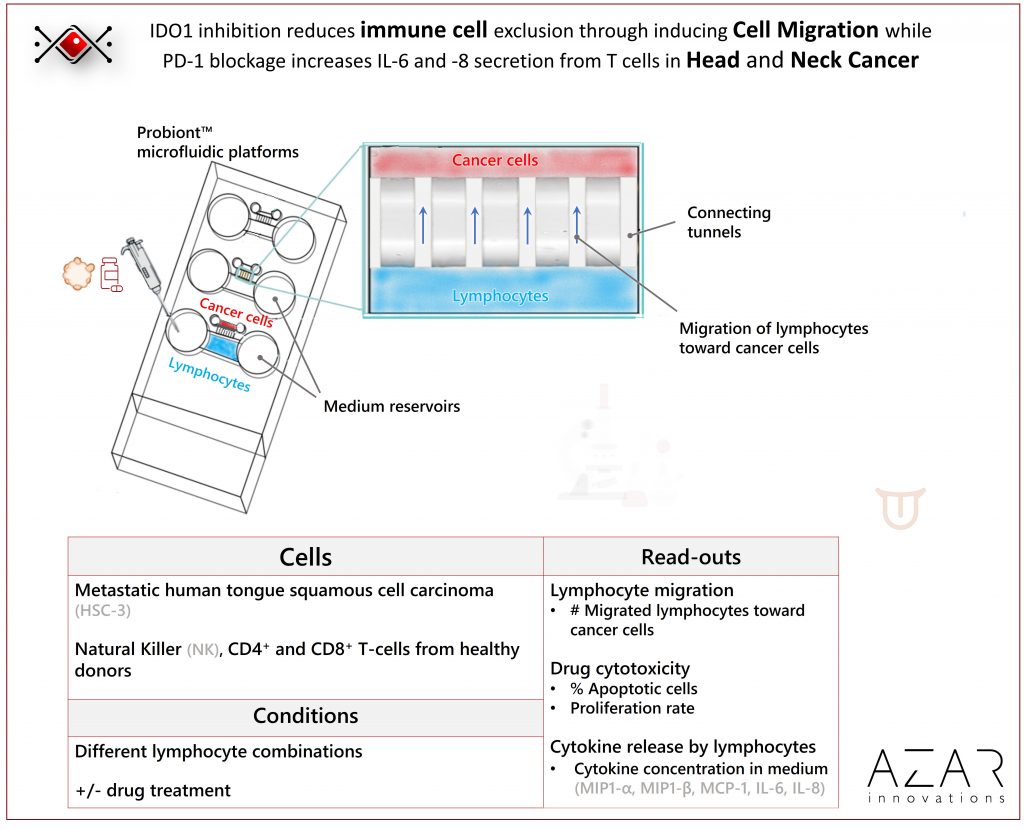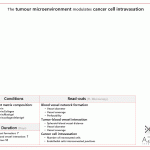Immune checkpoint inhibitors and their effects on lymphocytes and cancer cells in organ on a chip
How can you use a tumor on a chip platform to study the effect of immune checkpoint inhibitors (ICIs) on lymphocytes and cancer cells? This is a recent paper from Sieviläinen et al. at the university of Helsinki that uses an organ on a chip, lymphocytes and head and neck squamous cancer cells to investigate the effect of Immunotherapy with ICIs on different lymphocyte populations in terms of migration, cytotoxicity, and cytokine release in the presence of cancer cells.
Results
In this organ on a chip, HSC-3 cells (an oral tongue squamous cell carcinoma cell line) are co-cultured in the proximity of 3 types of lymphocytes: natural killer cells (NK), CD4+ and CD8+ T cells, as show in the image below. PD-1 antibody nivolumab and IDO1 inhibitor epacadostat were added to lymphocytes. This study revealed that epacadostat as an IDO1 inhibitor increased NK and CD4+ T cells migration toward cancer cells significantly, while nivolumab had no effect on lymphocyte migration. Even though ICIs were ineffective in CD8+ T cell migration, coculturing CD8+ with CD4+ cells increased their migration. Moreover, lymphocyte migration, especially in the presence of epacadostat increased HSC-3 cells apoptosis to some extent, but neither ICIs had an effect on cancer cell proliferation. Finally, by studying 17 cytokines after ICIs treatment, all of them showed an increased releasing trend, while only the fold changes in the concentration of MIP1-a from NK, IL-6 from CD8+ T cells, IL-8 from CD4+ T cells were significant.

Method
Lymphocytes were isolated from peripheral blood of healthy donors and FL-labeled, HSC-3 cell line was FL-labeled
Fabrication method: Commercially available
Sterilization method: Autoclaving
Cell incorporation: Cancer cells were suspended in hydrogel and loaded into cancer cell channels, lymphocytes were added to the lymphocyte channels in 2D
On-chip read-outs: End-point microscopy
Off-chip read-outs: Cytokine release, flow cytometry
Strong points:
+ 3 different subpopulations of lymphocytes
+ systematic study of effect of the drugs on individual lymphocytes
+ Lymphocytes isolated from human donors
Improvement points:
– More studies on the effect of cancer cell-lymphocyte ratio on the experiments are required
– The authors used PDMS but did not study the absorption of drug molecules into this material.
– A probable innate error in the visual analysis of the apoptotic cell layers due to cancer cells’ growth on top of each other (we appreciate the honesty of the authors to report this)
– Interesting to study the behavior of lymphocytes harvested from patients
Conclusions and outlook
A beautiful work that made the crosstalk between cancer cells and lymphocytes possible. It manifested lymphocytes subpopulations responded differently to ICIs. Future studies can reveal the relation between the levels of cytokine and the response to immunotherapy drugs!
Have questions about similar technologies or want to start with an organ on a chip systems? Contact us!
Citation: Sieviläinen M, Saavalainen J, Adnan-Awad S, Salo T and Al-Samadi A (2022) IDO1 Inhibition Reduces Immune Cell Exclusion Through Inducing Cell Migration While PD-1 Blockage Increases IL-6 and -8 Secretion From T Cells in Head and Neck Cancer. Front. Immunol. 13:812822. doi: 10.3389/fimmu.2022.812822
This article is reproduced under https://creativecommons.org/licenses/by/4.0/
The images in this post were modified for better clarity and the data were processed by AZAR Innovations.










